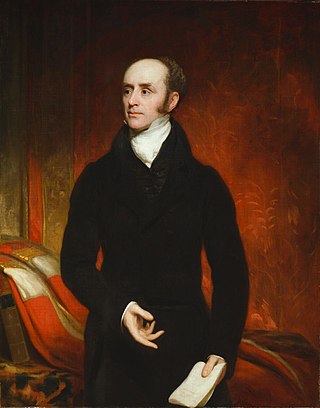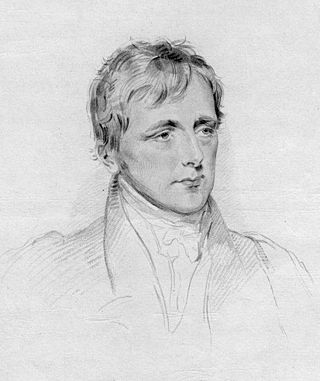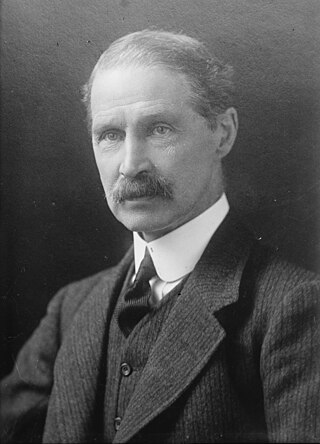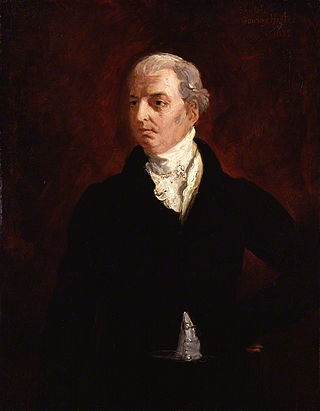The Canningites, led by George Canning and then the Viscount Goderich as First Lord of the Treasury, governed the United Kingdom of Great Britain and Ireland from 1827 until 1828.
The Canningites, led by George Canning and then the Viscount Goderich as First Lord of the Treasury, governed the United Kingdom of Great Britain and Ireland from 1827 until 1828.
On 9 April 1827 the Tory Prime Minister of the United Kingdom, Lord Liverpool, suffered a cerebral haemorrhage. He had been Prime Minister nearly fifteen years, ever since the assassination of his predecessor Spencer Perceval in May 1812. The man chosen to succeed him was the Foreign Secretary and Leader of the House of Commons, George Canning. Canning was very much on the moderate wing of the Tory Party, and many of the more hard-line members of Liverpool's government, including the Home Secretary, Sir Robert Peel, and national hero the Duke of Wellington (Master-General of the Ordnance), refused to serve under him. Canning's government was therefore recruited from the moderate wing of the Tory Party, known as the Canningites, with the support of several members of the Whig Party.
Canning, who was in poor health at the time of his appointment, died in office on 8 August 1827, and the Leader of the House of Lords F. J. Robinson, 1st Viscount Goderich, 1st Earl of Ripon succeeded him as Prime Minister. However, Goderich's government never even met in a session of Parliament, and was replaced by a High Tory government under the Duke of Wellington on 22 January 1828.
This is a list of the members of the government. Members of the Cabinet are indicated by bold typeface.

George Canning was a British Tory statesman. He held various senior cabinet positions under numerous prime ministers, including two important terms as Foreign Secretary, finally becoming Prime Minister of the United Kingdom for the last 119 days of his life, from April to August 1827.

Charles Grey, 2nd Earl Grey, known as Viscount Howick between 1806 and 1807, was a British Whig politician who served as Prime Minister of the United Kingdom from 1830 to 1834. He was a descendant of the House of Grey and the namesake of Earl Grey tea. Grey was a long-time leader of multiple reform movements. During his time as prime minister, his government brought about two notable reforms. The Reform Act 1832 enacted parliamentary reform, greatly increasing the electorate of the House of Commons.

William Wyndham Grenville, 1st Baron Grenville, was a British Pittite Tory politician who served as Prime Minister of the United Kingdom from 1806 to 1807, but was a supporter of the Whigs for the duration of the Napoleonic Wars. As prime minister, his most significant achievement was the abolition of the slave trade in 1807. However, his government failed to either make peace with France or to accomplish Catholic emancipation and it was dismissed in the same year.

William Henry Cavendish Cavendish-Bentinck, 3rd Duke of Portland, was a British Whig and then a Tory politician during the late Georgian era. He served as chancellor of the University of Oxford (1792–1809) and as Prime Minister of Great Britain (1783) and then of the United Kingdom (1807–1809). The gap of 26 years between his two terms as prime minister is the longest of any British prime minister. He was also the fourth great-grandfather of King Charles III through his great-granddaughter Cecilia Bowes-Lyon, Countess of Strathmore and Kinghorne.

Robert Banks Jenkinson, 2nd Earl of Liverpool, was a British Tory statesman who served as Prime Minister of the United Kingdom from 1812 to 1827. He also held many other important cabinet offices such as Foreign Secretary, Home Secretary and Secretary of State for War and the Colonies. He was also a member of the House of Lords and served as leader.

Frederick John Robinson, 1st Earl of Ripon,, styled The Honourable F. J. Robinson until 1827 and known between 1827 and 1833 as The Viscount Goderich, the name by which he is best known to history, was a British politician who served as Prime Minister of the United Kingdom from 1827 to 1828.

John William Ward, 1st Earl of Dudley, PC, FRS, known as the Honourable John Ward from 1788 to 1823 and as the 4th Viscount Dudley and Ward from 1823 to 1827, was a British politician and slave holder. He served as Foreign Secretary from 1827 to 1828.

George Frederick Samuel Robinson, 1st Marquess of Ripon,, styled Viscount Goderich from 1833 to 1859 and known as the Earl of Ripon in 1859 and as the Earl de Grey and Ripon from 1859 to 1871, was a British politician and Viceroy and Governor General of India who served in every Liberal cabinet between 1861 and 1908.

George Howard, 6th Earl of Carlisle of Castle Howard,, styled Viscount Morpeth until 1825, was a British statesman. He served as Lord Privy Seal between 1827 and 1828 and in 1834 and was a member of Lord Grey's Whig government as Minister without Portfolio between 1830 and 1834.

Benjamin Disraeli was appointed Prime Minister of the United Kingdom for a second time by Queen Victoria after William Ewart Gladstone's government was defeated in the 1874 general election. Disraeli's foreign policy was seen as immoral by Gladstone, and following the latter's Midlothian campaign, the government was heavily defeated in the 1880 general election, whereupon Gladstone formed his second government. The ailing Disraeli, by now created Earl of Beaconsfield, died in April 1881.
William Sturges-Bourne PC, known as William Sturges until 1803, was a British Tory politician. He was briefly Home Secretary under George Canning in 1827.

The Conservative Government of the United Kingdom that began in 1922 and ended in 1924 consisted of two ministries: the Law ministry and then the first Baldwin ministry.

Stanley Baldwin of the Conservative Party formed the second Baldwin ministry upon his reappointment as Prime Minister of the United Kingdom by King George V after the 1924 general election. His second ministry ended following the so-called "Flapper Election" of May 1929.
Canningites were a faction of British Tories in the first decade of the 19th century through the 1820s who were led by George Canning. The Canningites were distinct within the Tory party because they favoured Catholic emancipation and free trade.

The Conservative government of the United Kingdom that began in 1957 and ended in 1964 consisted of three ministries: the first Macmillan ministry, second Macmillan ministry, and then the Douglas-Home ministry. They were respectively led by Harold Macmillan and Sir Alec Douglas-Home, who were appointed by Queen Elizabeth II.

The 1830 United Kingdom general election was triggered by the death of King George IV and produced the first parliament of the reign of his successor, King William IV. Fought in the aftermath of the Swing Riots, it saw electoral reform become a major election issue. Polling took place in July and August and the Tories won a plurality over the Whigs, but division among Tory MPs allowed Earl Grey to form an effective government and take the question of electoral reform to the country the following year.

The Conservative government of the United Kingdom of Great Britain and Ireland that began in 1828 and ended in 1830 was led by the Duke of Wellington in the House of Lords and Robert Peel in the House of Commons.

Margaret Thatcher was Prime Minister of the United Kingdom from 4 May 1979 to 28 November 1990, during which time she led a Conservative majority government. She was the first woman to hold that office. During her premiership, Thatcher moved to liberalise the British economy through deregulation, privatisation, and the promotion of entrepreneurialism.

This is a list of members of the government of the United Kingdom in office under the leadership of Lord Liverpool from 1812 to 1827. He was appointed Prime Minister of the United Kingdom by the Prince Regent after the assassination of Spencer Perceval.